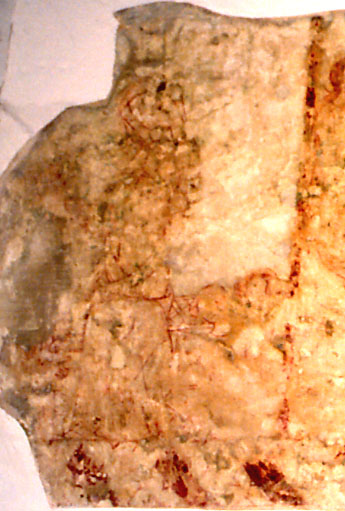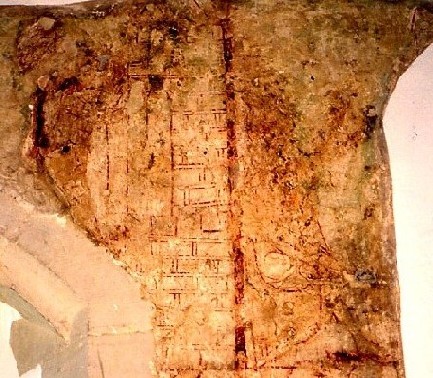Wendens Ambo, Essex (†Chelmsford) c.1330
Life of St Margaret

Very faded, but in general very similar to the painted Life of St Margaret at Charlwood in Surrey, and closely contemporary too (the given dates for both locations are Tristram’s). By far the most remarkable feature is the first scene in the narrative, showing Margaret being instructed by her (secretly Christian) nurse:
“…where she is shown, with other small girls, being taught by her nurse, as if in a ‘dame’s school’…It is a work in which naturalism is exceptionally strong…” ¹
This is the scene below left, faint and confusing as it now is. A tall female figure with a plain short headress and wrapped in a cloak, sits just to the left of centre on a bench-like seat still showing part of the cross-hatching usually used to denote padding or cushions – as at, for example, Corby Glen. This is Margaret’s nurse, and at the lower right are the faint outlines of two much smaller figures, probably Margaret’s classmates. Margaret herself is now hopelessly obscure, but she was originally standing at the left of the picture, holding out her book to her teacher, who points towards it with an extended index finger. Tristram’s 1934 drawing ² shows traces of a fourth small figure, kneeling in the foreground below Margaret and also holding a book.

The ‘instruction’ scene is unique among English painted lives of St Margaret now, but the remaining scenes resemble those at Charlwood very closely. At the left below, Margaret sits at the far left, holding a distaff. A hillside below her is implied, and it once had seven sheep on it. Further right, the herald of Olybrius, holding a narrow spear, or more probably, a banner-staff, kneels before Margaret, holding out to her a ring with a very large stone, clear in 1934 ³ but unfortunately quite obscure now. Below the herald,a faint whitish greyhound chases a slightly less faint red hare. Beyond to the right, Olybrius, holding the reins of a now virtually invisible white horse and once identifiable by his crown, follows, attended by a man on a red horse, and another attendant, probably on foot, at the right-hand edge.

Shown below at the lower right are the only remaining scenes in the narrative. The most prominent feature is the brickwork, intended, I think, as a battlemented perimeter wall, with a tall tower-like building beyond it, into which a jailer was once thrusting Margaret, again much as at Charlwood. I suspect that the perspectival failure with the brick-courses (otherwise painted with care) stem from this desire to show one structure, the prison-house, standing beyond another, the outer wall. To the right of the vertical dividing line, Olybrius or another authority-figure, once with a visible crown, sits cross-legged in judgement. Any further scenes, which might have included Margaret’s encounter with the dragon, have been destroyed by subsequent structual alterations to the church.
Traces of pigment can still be seen on all the walls at Wendens Ambo, but only St Margaret’s story remains.
Website for St Mary the Virgin, Wendens Ambo
¹ Tristram III, p. 90
² ibid. Plate 50b
³ ibid. Plate 49